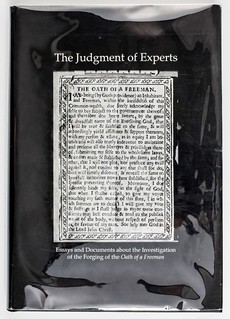
PREV ARTICLE
NEXT ARTICLE
FULL ISSUE
PREV FULL ISSUE
BOOK REVIEW: THE JUDGMENT OF EXPERTSEmily Isakson of the American Antiquarian Society published a blog article this week reviewing a great book with a numismatic connection. The Judgment of Experts: Essays and
Documents about the Investigation of the Forging of the Oath of a Freeman by James Gilreath discusses the strange case of master forger Mark Hofmann. In addition to the Mormon documents described
in the article, Hofmann was a numismatic ne'er-do-well who created very convincing counterfeits of rare Mormon paper money. Even expert Joe Rust, author of the reference book, Mormon and Utah
Coin and Currency was fooled. I was in the audience when Joe gave a great talk on the Hofmann forgeries at an American Numismatic Association convention. -Editor
Mark Hofmann was a book collector and missionary turned forger and murderer in the mid-1980s. Several of Hofmann’s earlier forgeries purported to be documents of historical importance to the Mormon Church. In 1985, Hoffman showed a New York dealer a small broadside called The Oath of a Freeman. It had been long reported that a printing of the Oath was done in Cambridge, Massachusetts, in 1638/39. This would likely be the first thing printed in America north of Mexico, though no surviving copy was known to exist. The broadside was offered to the Library of Congress for $1.5 million but ultimately the offer was declined because no conclusive evidence of the document’s genuineness could be found. The Oath was then offered to the American Antiquarian Society, who offered $250,000 with a number of stipulations requiring the dealers to try to establish the broadside’s authenticity at their own expense and to supply information about the owner of the Oath and its provenance. At this point negotiations ended. Now that the sale had fallen through, Hoffman, heavily in debt, was desperate to free himself. In an effort to mislead authorities, he planted bombs which killed two people. He was severely injured when a third bomb accidentally exploded in his car. Subsequent investigations uncovered the forgeries and led to Hofmann’s conviction. He is now well known as a murderer and forger, yet his faked items have found a market of their own, some selling for hundreds of thousands of dollars. What I became most interested in after reading about The Oath of a Freeman was the idea that some forgeries could yet have found their way into the AAS collection. With further exploration, I learned that the collection already contained forgeries, frauds, and even counterfeited materials ranging from vouchers, money, and checks to pirated papers, forged signatures, and even portraits. Still, there’s a question of whether or not AAS knew these items were frauds when they were acquired. (Discussions of these materials can be found in the AAS blog series “Fraud Week.”) Isakson includes a helpful link (reproduced below) to materials in the AAS collection related to forgery and counterfeiting. -Editor
Beyond these two examples, interesting still are all of the other materials in the AAS collection related to forgery and counterfeiting, such as counterfeit currency, forged letters and other fakes, and books on counterfeiting and hoaxes. But how does one accurately decipher whether or not something is a forgery? Nowadays, there are many ways to figure out what’s a fraud and what is genuine—namely advanced scientific methods such as ink and paper testing and handwriting analysis. Conversely, however, technological advances have allowed forgers and counterfeiters to create even more realistic duplicates. Forgeries have a long history, which is one of the reasons why it can be so difficult to tell what is truly real. But to all those historians and collectors out there, don’t worry—fakes can still turn out to be important pieces of history nonetheless. Here at AAS, our frauds have a special place in the collections. After all, they may have shaped the way that history, and the world, both was and is perceived. To read the complete article, see: To read the complete article, see: To read the earlier E-Sylum articles, see:  Wayne Homren, Editor The Numismatic Bibliomania Society is a non-profit organization promoting numismatic literature. See our web site at coinbooks.org. To submit items for publication in The E-Sylum, write to the Editor at this address: whomren@gmail.com To subscribe go to: https://my.binhost.com/lists/listinfo/esylum All Rights Reserved. NBS Home Page Contact the NBS webmaster 
|
